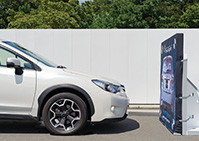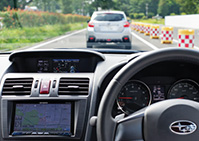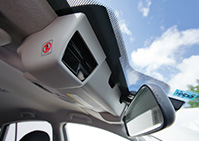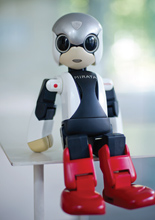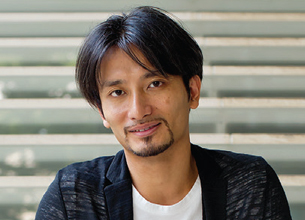- Home >
- Charms of Japan >
- LOOKING TOWARDS THE FUTURE >
- Infrastructure Building a legacy
LOOKING TOWARDS THE FUTURE
Infrastructure - Building a legacy
Infrastructure is a crucial element in any country's sustained development but in Japan's case it isn't only about building roads and bridges. Firms across the country are also working on major projects that include developing robots for disasters, adding smart safety technology to cars and using data to stay ahead of consumer trends.
CAR TECHNOLOGY
An extra pair of eyes
Many car makers have rolled out crash-avoidance technology but it's often expensive; Subaru offers an affordable solution in both its luxury and compact models. On a test course in Tokyo, Fuji Heavy Industries electronic product design chief Mamoru Sekiguchi drives towards a barrier to demonstrate the EyeSight system, which uses two cameras inside the windscreen to alert the driver and automatically hits the brakes.
“If I don't react on time the technology is there to help”, says Sekiguchi. EyeSight also adjusts the car's speed to keep a safe distance from cars ahead.
subaru.jp/eyesight
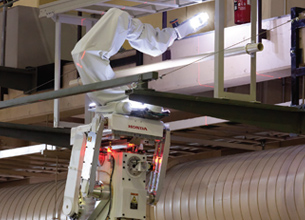
FUKUSHIMA POWERPLANT
A helping hand
After the 2011 earthquake and tsunami damaged the Fukushima Daiichi nuclear power
plant, car maker Honda Motor offered to help. Since June 2013, a remote-controlled robot that Honda developed with Japan's National Institute of Advanced Industrial Science and Technology has been helping workers investigate areas where radiation levels are high.
Adapted from Honda's humanoid robot Asimo it bends, twists and extends, peeking
into difficult-to-reach spaces. It shoots images, creates 3D maps and pinpoints radiation sources, all while minimising workers' exposure.
world.honda.com
CARBON-FIBRE TECHNOLOGY
Crossing that bridge
Carbon-fibre-reinforced plastic has been used in planes, cars and body armour but Mitsui Sumitomo Construction plans to put it to another use. The Tokyo firm, which co-developed the technology with West Nippon Expressway, will build new bridges using a carbon fibre called aramid.
This prevents rust, keeps the bridge standing for 100 years and cuts maintenance costs by up to 70 per cent. Another firm, Nippon Steel Sumikin Materials, is using carbon fibre to extend the lifespan of ageing bridges by 30 to 50 years.
nsmat.nssmc.com
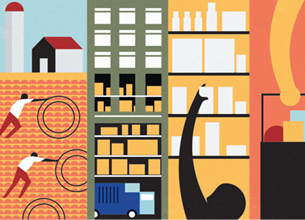
LOGISTICS
Retail knowhow
Every day, nine million customers walk into Lawson convenience stores in Japan. With a network of 11,384 shops and an everchanging mix of products, the company relies on a sophisticated logistics system to ensure that deliveries are made and shelves well stocked – and it's a science that Tokyo-based Lawson is refining.
The company is linking the consumer-behaviour patterns it collects from loyalty cards to orders it places with producers; it's also working with more producers on the items it sells.
“There's an element of trial and error now but eventually we could offer the knowhow to other companies”, says Tomoyuki Kawanabe, Lawson's supply-chain management specialist.
lawson.jp/en
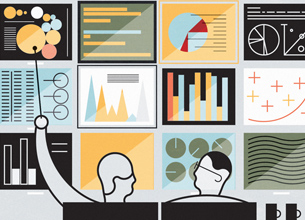
DATA MINING
Science of selling
It's the most talked-about tech trend in the business world: mining “big data”. The term refers to the act of sifting through huge databases for information to gain an edge over rivals. Car makers Honda and Toyota, hi-tech firms Fujitsu and Sony and wireless operators KDDI and DoCoMo are among a growing number of Japanese firms crunching the numbers. The data might reveal why consumers decide to buy or how to reduce traffic congestion.
Plus, given how discerning their local consumers are, Japanese companies could use this data to help businesses elsewhere anticipate
trends in their own markets.
ARTIFICIALINTELLIGENCE
Friendly robot
In August, a 34cm-tall robot called Kirobo (left) introduced itself at the International Space Station and became the first talking humanoid robot to blast into orbit.
Developed by University of Tokyo researcher Tomotaka Takahashi (right) and Toyota Motor, Kirobo can recognise voices and hold a conversation.
kibo-robo.jp/en
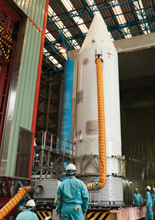
SPACE POLICY
Lift-off for ideas
Japan's space policy has a new set of priorities. The Japan Aerospace Exploration Agency (JAXA) is now focusing on projects that align with national security policies and offer benefits to the corporate sector. This includes a constellation of satellites that gives Japan its own GPS network and another set to help Southeast Asian nations with disaster preparedness.
Attention-grabbing missions are getting the nod, too.
Hayabusa2, set to launch by 2015, will spend four years travelling from Earth to collect samples from an asteroid that could offer clues about the origin of our solar system.
jaxa.jp/index_e.html








